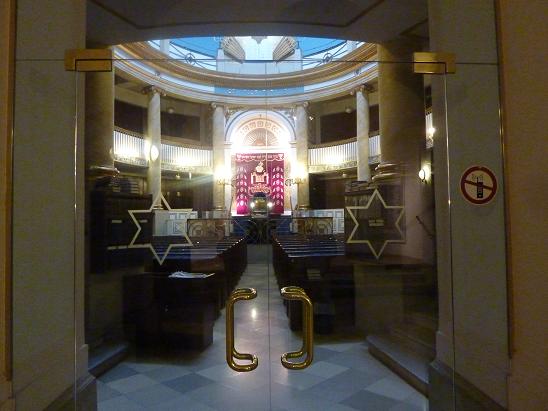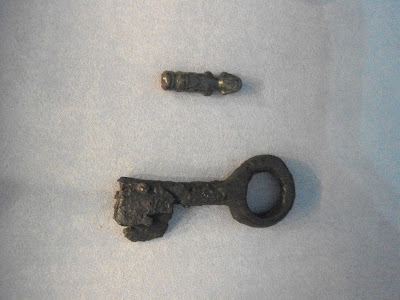To celebrate my last Saturday in Vienna, I decided I would spend Shabbat at the Stadttempel, Wien.
The men meet at 9 a.m. downstairs and the women trickle in between 10-10:15 a.m. in the upstairs.
As I arrived I was surprised when three police officers met me on the street corner of Seitenstettengasse I looked down the street and there was another police van surveying the opposite corner.
I had noticed a few police in the area during the week but I figured it was because I was in the throws of the Viennese “Bermuda Triangle,” der
Bermudadreieck.
Come to find out that the security was indeed for the Stadttempel, with extra pre-cautions taken on Shabbat. Police surrounded the Synagogue. I was taken aback by the presence of the armed guards, with what looked to me like semi-automatic rifles. They asked me where I was headed and I asked them, “Darf ich in die Synagoge gehen?” They waved me through and then a man and woman met me at the entrance of the Synagogue. They were in dark suits and were wearing earpieces; they reminded me of bodyguards.
As if finding armed guards on the street corner was not surprise enough, what happened next caught me even more off guard. The Temple guards proceeded to question me for a good 5-10 minutes before they let me in. They asked me my full name and requested a form of identification. The first picture ID I found was my museum pass which was not good enough, they needed an official ID like a passport. I asked them if my California driver’s license would do since I left my passport in my apartment. It sufficed. Next they asked me a whole battery of questions: where was I from, why was I in Vienna, who do I know in Vienna, how long have I been there, does anyone in Vienna know I am at the Temple today, does anyone in the U.S. know I am at the temple today, do I practice Judaism in my home country, do I attend synagogue in my home town, how often…? Each time they asked a question they looked up at me and then down at my ID. I was almost positive they were going to catch me in a lie—I wondered if they could tell I was not 100% truthful about my weight and I do not really know my actual height. Each time I answered a question it seemed to inspire another.
Then they asked me about what I had in my pockets, and my bag. I told them what I remembered having: a notebook, pencil, and camera (which I decided not to use so I would not be asked to leave). They wanted to see it all and they asked me to turn on the camera. The last entrance exam was a pat down and then I was deemed safe to enter. They told me I was free to go upstairs. Needless to say I was ecstatic when I gained entry although still a little rattled by the ordeal.
 The service was indeed beautiful. I listened to the Rabbi read the Torah in Hebrew, so I knew even less about what was being read than if it was in German. Either was I loved watching and listening—it was so melodious. At one point the Rabbi had all young boys join him and he led them in a few Psalms with call and response. Then as they finished, another Rabbi collected the scrolls and brought it around so all in attendance could kiss it. Then they opened the curtains behind the altar, where there were a number of other scrolls each one robed and crowned (photo stolen from http://www.kiwiblog.co.nz/tag/dpf.)
The service was indeed beautiful. I listened to the Rabbi read the Torah in Hebrew, so I knew even less about what was being read than if it was in German. Either was I loved watching and listening—it was so melodious. At one point the Rabbi had all young boys join him and he led them in a few Psalms with call and response. Then as they finished, another Rabbi collected the scrolls and brought it around so all in attendance could kiss it. Then they opened the curtains behind the altar, where there were a number of other scrolls each one robed and crowned (photo stolen from http://www.kiwiblog.co.nz/tag/dpf.)
 As I sat in the temple I could not help but ponder its history and Vienna’s tragic Jewish history of persecution. Vienna’s first Synagogue was destroyed in a cleansing crusade against the Jews in 1421. Vienna under the rule of Albrecht V burned the medieval Synagogue to the ground along with 212 wealthy Jews. The first synagogue was forgotten and buried until it was unearthed during the construction of Rachel Whiteread’s memorial to the murdered Austrian Jews. The cleansing of the city however, was celebrated in the 16th Century with a plaque that reads:
As I sat in the temple I could not help but ponder its history and Vienna’s tragic Jewish history of persecution. Vienna’s first Synagogue was destroyed in a cleansing crusade against the Jews in 1421. Vienna under the rule of Albrecht V burned the medieval Synagogue to the ground along with 212 wealthy Jews. The first synagogue was forgotten and buried until it was unearthed during the construction of Rachel Whiteread’s memorial to the murdered Austrian Jews. The cleansing of the city however, was celebrated in the 16th Century with a plaque that reads:
Flumina Jordani tergunturlabe malisque
Corpora cum cedit, quod latet omne nefas.
Sic flamma assurgens totam furibunda
Per urbem 1421 Hebraeum purgat crimina
saeva canum. Deucalioneis mundus purgatur
ab undis sicque iterum poenas igne furiente luit.
For those, like me who cannot read Latin, it translates:
In the waters of the Jordan, their bodies were cleansed of filth and malady. And all that was hidden and sinful disappeared. Thus, rose in 1421 the flames of hatred throughout the city and expiated the horrible crimes of the Hebrew dogs. As the world once was cleansed by the Deucalion Flood, so were all the sins atoned in the raging flames.




Under Leopold I, the Jewish community in Vienna was banished in 1670. Maria Theresia hated the Jews and expelled them from Prague and Bohemia in 1744 (then repealed in 1748). While Maria Theresia’s expulsion was not upheld, her hatred sustained: “ ‘I know of no greater plague than this race, which on account of its deceit and hoarding of money is driving my subjects to beggary.’” Her son, Josef II, the “Enlightened Absolutist” made a place for the Jews in Vienna and was known as “Emperor of the Jews.” Josef II legislated the Tolerance Edicts of the 1780s, which lifted the Jew tax and other restrictions. This new tolerance allowed the Jews new opportunity in the community, economics and education with new freedom the Jews enjoyed a Maskilim, Jewish Enlightenment, but still restricted by the Familiants Laws, residency. Building “restrictions” also remained on Synagogues, which would prove helpful to the Stadttempel in the century following its construction.
Josef Kornhäusel was the architect whose “greatest achievement” was the Stadttempel built in 1826. It was built in a city that only allowed Christian houses of worship in the inner city to be accessible from the street. In addition The Jewish Synagogue could not look like a Jewish Synagogue from the outside so as not to compete with the beautiful Baroque churches and Christian faith. It was built sharing walls of adjacent buildings. When the Nazis took over the city in 1938, the Stadttempel was the only synagogue that survived Kristallnacht the November Pogrom. The Nazis gutted the Synagogue of all things Jewish, but the building was not burned down to the ground like the others in the city in order to preserve the other buildings in the inner city block.
Today over 70 years later I am sitting in the same synagogue that survived the Nazis and their occupation. As I look around at the congregation I wonder about the grey-haired men sitting below. Sitting across from me is a little Jewish woman who looks to be at least the same age as Thomas Frankl. I wonder if they ever ponder their synagogue and its survival in the same manner as me, or if their life and breath is an even more remarkable story of survival than the building. The Nazis gutted this building in 1938 and used its records of Jewish births to aid them in proving Jewish race, address and connection with those “cleaned up” by Eichmann. These people, living in a city that continually tried to eradicate them, still remain and I think of Ruth Kluger’s novel Still Alive and hope to read her German novel Weiter Lebens (which translates living and still living).
Le Chaim.


